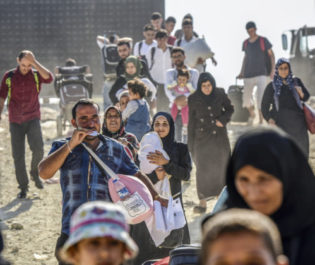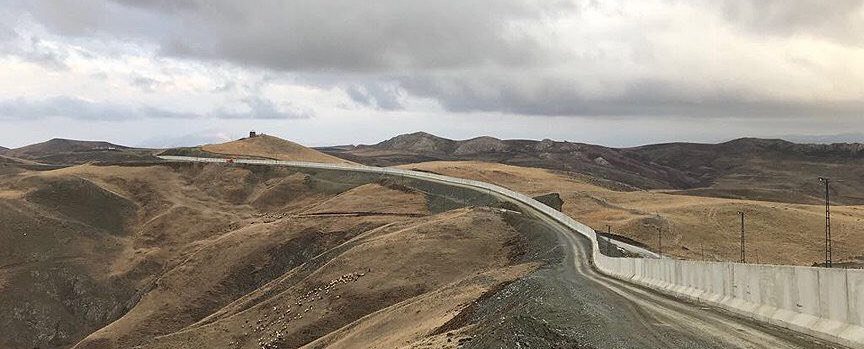Turkey and the Middle-East: From Imperial Temptation to National Closure
In the early 2010s, at the initiative of its Minister of Foreign Affairs, Ahmet Davutoglu, Turkey launched a “Neo-Ottoman” diplomacy which, capitalising on the Arab Spring, sought to restore Turkey’s status as a leader in the Middle East. Regional rivalries and questions of identity that Turkey refuses to address have put paid to this ambition. A symbol of the new parochialism is the 764-kilometre-long wall along the Syrian border, completed in June 2018.
Following the failure of the Ottoman reforms (Tanzimat) and of the Pan-Islamism of Sultan Abdul Hamid II, the Young Turks gave themselves the task of “saving the Ottoman state”. But the ray of hope in their 1908 revolution was to prove very short-lived. Unable to halt the territorial losses or to fulfil the aspirations of the Ottoman peoples, they installed an authoritarian regime and advocated Pan-Turkism, i.e., recasting the Ottoman Empire along ethnic lines to encompass all Turks as far away as Central Asia. They dragged the Empire into the Great War and thereby triggered its dissolution. However, after leading a victorious war of independence, one of their number, Mustafa Kemal (Atatürk), turned his back on territorial Pan-Turkism and the Ottoman and Muslim past to create a homogenised and Westernised (secularised) Turkish nation, limited to the borders of today’s Turkey.
It was only at the end of the Cold War that Turkey’s interest in the Middle East was rekindled and it sought to become a regional power. The government of the AKP – the Justice and Development Party, which came to power in 2002 – carried on with this policy called “Neo-Ottomanism”. The AKP played an active role in the creation of a “Shamgen” space (a reference to Sham, “Damascus” in Arabic, and to the Schengen space), abolishing visas, organising interministerial meetings, intensifying economic and cultural relations and, together with Syria, Jordan and Lebanon, setting up a High-Level Cooperation Council modelled on the European Union (EU).
Domestically, while engaging in a battle against the Kemalist establishment, the AKP adopted a more flexible and conciliatory attitude on numerous issues (democratisation, Kurdish “questions”, human rights, etc.). It mobilised Ottoman and Islamic references to resolve the “Kurdish question” in Turkey and improved economic relations with Iraqi Kurdistan.
A SHORT-LIVED NEO-OTTOMANISM
Barack Obama gave his backing for this activism motivated by Turkey’s desire to reconcile Islam and democracy. There was support for promoting the “Turkish model” in the Arab world. The accession to power of Islamist parties with a certain ideological proximity to the AKP encouraged Turkey in its quest for regional leadership. At the time of the popular uprisings in Syria, Turkey – convinced that the regime would be quickly toppled – broke off relations with the Syrian government, opened its borders to refugees and provided assistance to the Syrian opposition, only to find itself rapidly confronting a Damascus-Baghdad-Tehran axis supported by Russia.
The Islamisation of the Syrian rebellion, furthermore, led Western states to refuse to support the Turkish position. The number of refugees climbed into the millions and, in March 2015, Turkey closed its border with Syria. In August 2015, the first section of the border wall was constructed in Reyhanli. Rocket attacks from Syria and attacks by jihadist organisations on its own territory strengthened its resolve. Neo-Ottomanism had reached its limits.
THE KURDISH QUESTION
 Syrian refugees arrive at the Oncupinar crossing gate, close to the town of Kilis, south central Turkey, in order to cross to Syria for the Eid al-Adha Muslim holiday, on 28 August 2017.
Syrian refugees arrive at the Oncupinar crossing gate, close to the town of Kilis, south central Turkey, in order to cross to Syria for the Eid al-Adha Muslim holiday, on 28 August 2017.Despite its attempt to find a political solution to the “Kurdish Question”, the AKP had been refusing to grant political rights to the Kurds and focussing on disarming the PKK (Kurdistan Workers’ Party), for which the regional chaos had provided a greater margin for manoeuvre. In the summer of 2012, taking advantage of the Syrian army’s retreat, the Syrian Kurds created an autonomous zone. Under attack from the Islamic State (IS) in 2014, Kurds in Iraq and Syria stopped its advance, winning them the sympathy of international public opinion and military support from the anti-IS coalition. The Turkish government’s hostility towards Kurdish autonomy in Syria and its complacency towards jihadist movements, in particular during the siege of Kobanî, radicalised Kurdish mobilisation in Turkey, leading to the virtual disappearance of the border between Kurds in the two countries.
Destabilised by the protests of the Gezi Park movement and the fight against the Gülen movement, Erdogan became convinced of a plot to overthrow his government, similar to that against Mohamed Morsi in Egypt. He took a more authoritarian and repressive line against the opposition. In the June 2015 parliamentary elections, the pro-Kurdish Peoples’ Democratic Party (HDP) exceeded the 10% electoral threshold, depriving the AKP of its absolute parliamentary majority. The Turkish government feared attempts at Kurdish autonomy in Turkey, all the more as at the same time groups of young PKK affiliates were fighting and experimenting with self-governance in several Kurdish towns. Putting an end to the peace process that had been initiated in 2009 and resumed in 2013, Turkey once again cracked down on Kurdish claims both inside the country and abroad. The attempted coup d’état in 2016 was the high point of this development: in order to consolidate its power and preserve the conservative majority’s hold over the country, the government spoke urgently of an existential danger for Turkey presented by the Kurds and the Gülenists supported by the United States and Israel in their quest to break up the Middle East*, consolidated its alliance with the ultranationalists and overhauled the political system through the move to a presidential regime.
A WALLED-IN COUNTRY
A transit country at once for European jihadists travelling to Syria, for jihadists on their way to carrying out attacks in Europe, as well as for Syrian refugees headed for the Schengen space, Turkey came under substantial international pressure to close its border with Syria.Like other walls across the world, the Turkish wall is the expression of the contradictions of a state which is walling itself at great speed while simultaneously criticising “citadel Europe” and an Israeli “wall of shame The agreement it reached with the European Union in March 2016 therefore reinforces the objective of creating an impassable border with Syria by constructing a wall. In June 2018, Turkey announced that 764 kilometres of the “Turkish wall” had been completed, a wall which will eventually run along the entire 911-kilometre-long Syrian border. Another wall is under construction at the border between Turkey and Iran and discussions are underway regarding a third wall along the Armenian border. The border with Greece is already closed by a barbed wire fence and security measures in which the Frontex agency participates. Finally, the border with Bulgaria is likewise closed by a barbed wire fence constructed by Bulgaria.
Like other walls across the world, the Turkish wall is a symbol of withdrawal and closure. It is also the expression of the contradictions of a state which is walling itself at great speed while simultaneously criticising “citadel Europe” and an Israeli “wall of shame”. Accompanied by a policy of resettlement on both sides of the border, it is reinforcing the separation of the Kurds by obstructing longstanding economic and cultural relations between cities and families on either side, at the risk of asphyxiating Kurdish autonomy in Syria and elsewhere.
While at the same time denouncing the authoritarianism and human rights violations in Turkey, the EU is contributing to this security-oriented approach to migration by providing the country with financial assistance and surveillance technologies. The wall expands the market for traffickers, increases criminality and pushes numerous migrants towards more dangerous routes. According to Human Rights Watch, which has criticised the EU for its silence, the wall is the symbol of massive human rights violations of asylum seekers, in particular those who lose their lives to the bullets of border guards or those who are summarily deported to war zones.
Fact Sheet: The Wall between Turkey and Syria
Origin
- In March 2015, Turkey closed its border with Syria.
- In August 2015, the first section of the border wall was constructed in Reyhanli.
- The wall was completed in June 2018.
Size: 764 kilometres.
Cost: not known.
Info: in September 2018 the number of Syrian migrants in Turkey surpassed 3.5 million (UNHCR Refugees Operational Portal).
Increasing Number of Walls in the World, 1945–2018
Based on Samuel Granados, Zoeann Murphy, Kevin Schaul and Anthony Faiola, “Raising Barriers: A New Age of Walls”, The Washington Post, 12 October 2016.
United States/Mexico
India/Bangladesh
Kenya/Somalia
South Korea/North Korea
Turkey/Syria
Israeli West Bank Barrier
1,120 km between California and Texas, around a third of the total border length of 3,141 km.
Origins
- In 1994, US Border Patrol installed sensors and stronger fencing in San Diego, California, and El Paso, Texas. In the fall of 2006, the Congress authorised the construction of 700 miles of fencing in rural areas in California and Arizona. In January 2017, President Trump signed an Executive Order to begin the extension of the border wall.
The fence covers 3,200 km of the 4,096.7-km-long border
Origins
- The fence finds its origin in the Assam Accord of 1985 signed between representatives of the Government of India and the leaders of the sub-national Assam Movement. The accord accommodated the claims of the Assam Movement to keep out irregular migrants. The construction of the fence started in 1993.
8 km already done of the 700-km-long project
Origins
- Following the siege of Garissa University in 2015, the Kenyan government announced the construction of the wall.
- Project stopped in January 2018 to open negotiations with the Somalian Government.
764-km-long wall
Origins
- In March 2015, Turkey closed its border with Syria.
- In August 2015, the first section of the border wall was constructed in Reyhanli.
- The wall was completed in June 2018.
The DMZ is 250 km (160 miles) long and about 4 km (2.5 miles) wide.
Origins
- In the Armistice Agreement of 27 July 1953, the DMZ was created as each side agreed to move their troops 2,000 m (2,200 yards) back from the front line, creating a 4-km-wide (2.5-mi-wide) buffer zone.
700 km.
Origins
- The barrier was built in 2002, during the Second Intifada that had begun in September 2000, and was officially justified by the Israeli need of security against the wave of violence.
Definition of “Wall”
"The English word ‘wall’ is derived from the Latin vallus meaning a ‘stake’ or 'post’ and designated the wood-stake and earth palisade which formed the outer edge of a fortification. Walls have traditionally been built for defense, privacy, and to protect the people of a certain region from the influence or perceived danger posed by outsiders” (from Joshua J. Mark, Ancient History Encyclopedia, https://www.ancient.eu/wall/).
Walls are social constructions that are often used in a metaphorical sense, serving as canvas to cultural and/or political projections. An example in point is the 1979 album The Wall of the progressive/psychedelic rock band Pink Floyd. Physical walls are the offspring of our mental walls but physical walls, in turn, also impact our mental maps and the way we configure spatial identities and alterity.
In academic terms, walls have further been described as “an exercise in verticality” (Carl Nightingale), as “top-down controlled sluices of human movement, points of banishment, and perfect locations for tax collection” (Carl Nightingale), as “material things with symbolic meaning” (Tamar Herzog) and, finally, as “sites of negotiation and practice-making or -following” (Tamar Herzog).
All quotes from Suzanne Conklin Akbari, Tamar Herzog, Daniel Jütte, Carl Nightingale, William Rankin and Keren Weitzberg, “AHR Conversation: Walls, Borders, and Boundaries in World History”, American Historical Review 122, no. 5 (2017): 1501–1553, doi:10.1093/ahr/122.5.1501.
